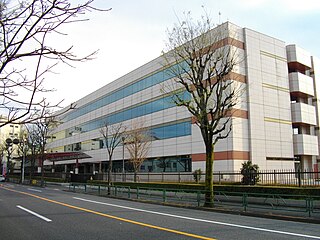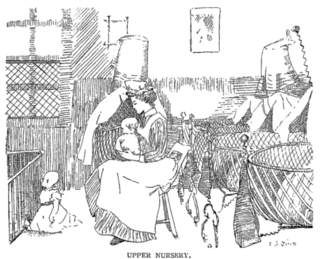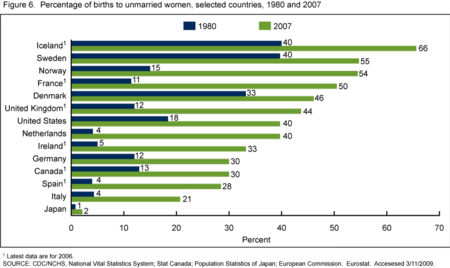
Childcare, otherwise known as day care, is the care and supervision of a child or multiple children at a time, whose ages range from two weeks of age to 18 years. Although most parents spend a significant amount of time caring for their child(ren), childcare typically refers to the care provided by caregivers that are not the child's parents. Childcare is a broad topic that covers a wide spectrum of professionals, institutions, contexts, activities, and social and cultural conventions. Early childcare is an important and often overlooked component of child development.

Birth rate, also known as natality, is the total number of live human births per 1,000 population for a given period divided by the length of the period in years. The number of live births is normally taken from a universal registration system for births; population counts from a census, and estimation through specialized demographic techniques. The birth rate is used to calculate population growth. The estimated average population may be taken as the mid-year population.

Parental leave, or family leave, is an employee benefit available in almost all countries. The term "parental leave" may include maternity, paternity, and adoption leave; or may be used distinctively from "maternity leave" and "paternity leave" to describe separate family leave available to either parent to care for small children. In some countries and jurisdictions, "family leave" also includes leave provided to care for ill family members. Often, the minimum benefits and eligibility requirements are stipulated by law.
Social security in Sweden is an aspect of the Swedish welfare system and consists of various social insurances handled by the National Agency for Social Insurance, and welfare provided based on need by local municipalities. Social security is the main conduit for redistribution of approximately 20% of the Swedish GDP mainly in the form of income taxes, Payroll taxes and Value added taxes.
Natalism is an ideology that promotes the reproduction of human life as an important objective of being human and advocates high birthrate. According to the Merriam-Webster dictionary, the term, as it relates to the belief itself, dates from 1971 and comes from French: nataliste, formed from French: natalité, birthrate.

Temporary Assistance for Needy Families is a federal assistance program of the United States. It began on July 1, 1997, and succeeded the Aid to Families with Dependent Children (AFDC) program, providing cash assistance to indigent American families through the United States Department of Health and Human Services. TANF is often simply referred to as welfare, but some argue this is a misnomer. Unlike AFDC, which provided a guaranteed cash benefit to eligible families, TANF is a block grant to states that creates no federal entitlement to welfare and is used by states to provide non-welfare services, including educational services, to employed people.
Social welfare, assistance for the ill or otherwise disabled and the old, has long been provided in Japan by both the government and private companies. Beginning in the 1920s, the Japanese government enacted a series of welfare programs, based mainly on European models, to provide medical care and financial support. During the post-war period, a comprehensive system of social security was gradually established. Universal health insurance and a pension system were established in 1960.
A mommy track is a path in a woman's life that puts priority to being a mother. It can also specifically refer to work arrangements for women in the workforce that facilitate motherhood, such as flexible hours, but at the same time usually provides fewer opportunities for career advancement. References to the mommy track often go along with being a housewife, "opting out" of the workforce, temporarily or even permanently. Women following the mommy track may be contrasted to career women who prioritize their careers more than having children.

Feminism in Japan began with women's rights movements that date back to antiquity. The movement started to gain momentum after Western thinking was brought into Japan during the Meiji Restoration in 1868. Japanese feminism differs from Western feminism in that less emphasis is placed on individual autonomy.

Japan has the highest proportion of elderly citizens of any country in the world. 2014 estimates showed that about 38% of the Japanese population was above the age of 60, and 25.9% was above the age of 65, a figure that increased to 29.1% by 2022. By 2050, an estimated one-third of the population in Japan is expected to be 65 and older.

The Japan Pension Service is a Government organization administered by the Ministry of Health, Labour and Welfare. On January 1, 2010, it replaced the Social Insurance Agency.

Child care in the United Kingdom is supported by a combination of rights at work, public sector provision and private companies. Child care is usually undertaken by the parents, and more often the mother who takes leave from employment. Early childhood education in a crèche or nursery is not freely available from the public sector, while fee-paying pre-schools are.
Social security in Germany is codified on the Sozialgesetzbuch (SGB), or the "Social Code", contains 12 main parts, including the following,
Work–family balance in the United States differs significantly for families of different social class. This differs from work–life balance: while work–life balance may refer to the health and living issues that arise from work, work–family balance refers specifically to how work and families intersect and influence each other.
The Organisation for Economic Co-operation and Development provides data about OECD countries related to paid parental leave length, average pay rate and full-rate equivalent. Not all countries provide mothers with a pay rate equal to what they would have received if the absence had not occurred.
Luxembourg has an extensive welfare system. It comprises a social security, health, and pension funds. The labour market is highly regulated, and Luxembourg is a corporatist welfare state. Enrollment is mandatory in one of the welfare schemes for any employed person. Luxembourg's social security system is the Centre Commun de la Securite Sociale (CCSS). Both employees and employers make contributions to the fund at a rate of 25% of total salary, which cannot eclipse more than five times the minimum wage. Social spending accounts for 21.8% of GDP.
Marriage legislation has a long tradition in the Netherlands. The minimum age at marriage was set in the 1811 Civil Code, amended in 1838. Same sex marriage was allowed in 2001. The first Family Allowance Act was introduced in 1941, and provided benefits only to working families with more than two children. In 1947, the income dependency was abolished and wage earners were also entitled to an allowance for their first and second children under 18 years old. In 1963, family allowances were extended to self-employed people. Currently, all families living in the Netherlands are entitled to a family allowance if their child is younger than 18 years old. In 1956, the Netherlands passed the Nursery Education Act that funded preschool; however, in 1981, preschool was added to the standard education system. The Childcare Act of 2005 gave childcare an official framework which provided funding and supervision for many programs.

In South Korea, aging refers to an increase in the proportion of senior citizens to the total population. The term "senior citizens" include those aged 65 or older. According to Article 3 no.1 of the Framework Act on Low Birthrate of an Aging Society, the term "aging population" refers to the increasing proportion of elderly people in the entire population.
Primary responsibility for early learning, preschool and child care in Canada rests with the 13 provincial and territorial governments. Since 1984, there have been a number of unsuccessful attempts at establishing a national child care system. By 2019 in Canada, about 60% of children who were 0 to 5 years-old participated in day care arrangements. Of these, 52% were in formal day care settings and 26% were cared for by a relative in an informal setting. About 40% of parents had difficulty finding child care arrangements. As of 2016, 30% of child care operations in Canada were for-profit, which includes large single-owner corporate chains. Some federal, provincial, territorial, and municipal public funding of child care is limited to not-for-profit child care operations.
















